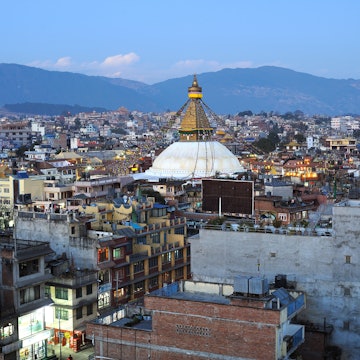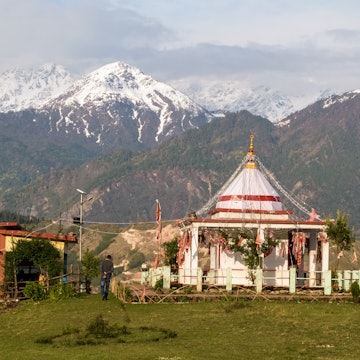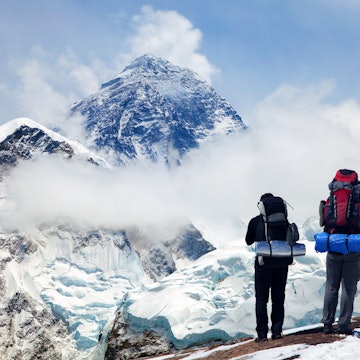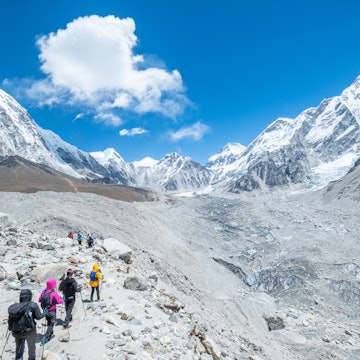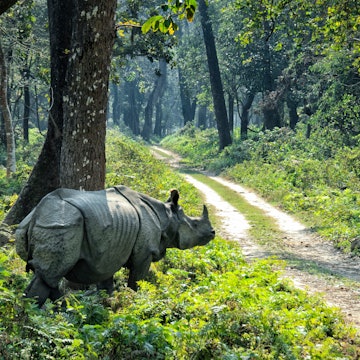

Sleep in community-run homestays to experience the best of Nepal’s Kathmandu Valley © Joe Bindloss / Lonely Planet
Lonely Planet writer Joe Bindloss recently traveled around Nepal’s Kathmandu Valley, staying in community-run homestays. Here, he shares some tips and insights for anyone looking to plan a similar trip.
For most of the travelers who descend into the hill-ringed airport in Kathmandu, Nepal is all about trekking, ideally on the breathless trails snaking around Sagarmatha (Mt Everest) and the Annapurna and Manaslu mountain ranges. But while the mountains are undeniably majestic, above the snowline, there isn’t much more than rocks and ice. Nepal’s cultural heartland lies in the Middle Hills, the green band of highlands dividing the Himalayas from the Terai plains, and it was this area that I wanted to explore in more detail.
The three former city-states that dominate the Kathmandu Valley – Kathmandu, Patan and Bhaktapur – are firmly on the traveler map thanks to their towering temples and palace-crowned medieval squares, but I wanted to see more of the valley, and find out how people lived away from the clicking cameras.
Staying at community-run homestays dotted around the valley was a window onto a different Nepal, away from the trekking trail bustle. In place of mountain passes and trekking chitchat, I got to sit in on community dances, tag along on temple trips, chip in at mealtimes, and get my hands dirty trying traditional crafts – all the time learning more about Nepal through its people. Here’s what I discovered.

Where did you stay? What was the vibe?
Hopscotching around the valley from Kathmandu to Thimi, Bhaktapur, Nagarkot, Namobuddha, Panuati and Kirtipur, I stopped overnight at a series of family-run homestays, arranged through the Community Homestay Network in Kathmandu – a pioneering organization that aims to redistribute income from tourism to rural communities. Control of the project lies in the hands of local women, many of whom achieved financial autonomy for the first time when they joined the homestay network.
In the ridgetop village of Nagarkot, I was hosted for several nights by Sarada Bastola and her son Anup, staying in a simply decorated but comfortable bedroom in their family shophouse, built to replace the family’s mudbrick farmhouse, which was destroyed in the 2015 Nepal earthquake. It was a bit like staying with friends of friends – we shared a bathroom and homecooked meals (mostly of vegetables grown in the village) were taken together in the family kitchen or out on the rooftop.
I spent one night in more conventional accommodation so I could be close to the hilltop Thrangu Tashi Yangtse Monastery at Namobuddha, stopping over in a slate-roofed, Nepali-style cottage at the charming Namobuddha Resort. My room looked out over a lush tropical garden teeming with barbets, woodpeckers, drongos, bulbuls, babblers, flycatchers and other Himalayan birds. The multi-throated dawn chorus was quite something!
My hosts in Panauti were Ruku Shrestha and her children, Aaditya and Jyoti, who put me up in a roomy bedroom in their bazaar-side home, backing onto the homestay association’s social hall. It was a fascinating introduction to the tight sense of community in this small country town. In between hosting me and hustling the children off to college, Ruku zipped around the neighborhood, supporting other village women as part of a community-led project based on microloans and shared labor.

What was the best thing you ate?
Everyone who travels to Nepal falls in love with momos, the local dumplings, but the experience is even more magical when you make them yourself. Learning from locals is a core part of the Community Homestay experience, and my hosts in Panauti set aside an evening for a crash course in making the perfect momo.
In fact, I didn’t make one momo, I made dozens of them. While matriarch Ruku focused on chopping up ingredients, Aaditya and Jyoti guided me through the essentials of momo-making, beginning with mixing together a huge mound of minced buffalo meat, vegetables and momo masala (the blend of Nepali spices that gives Nepali momos their distinctive flavor).
Next came the momo wrappers, prepared from a simple wheat-flour and water dough. We quickly established an efficient production line, with Jyoti splitting the dough into balls, Aaditya rolling the balls flat with a miniature rolling pin, and the three of us stuffing in the filling and pinching the wrappers together to make neat parcels.
Admittedly, mine looked more like tortellini than the classic "drawstring bag" momo shape, but after a quick steaming, the results were delicious.

What was the most under-the-radar activity you enjoyed?
I learned how to throw a clay pot in the pottery-making village of Thimi. While neighboring Bhaktapur is famous for pottery (there’s even a whole medieval square devoted to potters) many of the best artisans come from Thimi, and I joined a morning class with the owner of NP Ceramics to learn the basics of this traditional Nepali artform.
My teacher, Nara Bhakta Prajapati, grew up making traditional water ewers and deity-adorned flowerpots before graduating to high-grade, wheel-spun ceramics. He talked our small group of amateurs through the stages of making a wheel-turned bowl from glacier-ground local clay, mined from the base of the Kathmandu Valley.
In practice, throwing a pot was harder than it looked, but Nara was an attentive and patient teacher, stepping in to correct wonky edges and thin out chunky pot rims. With some assistance, I managed to produce a passable, more-or-less-round pot, which was dried, fired in the village’s communal kilns, and delivered to me in Kathmandu at the end of my trip.

Favorite activity from the trip?
Being introduced to the landscape by locals was a real highlight of my visit. In Nagarkot, walking along the ridge from the village’s Buddha Peace Park with my homestay host Anup, I got to see the countryside through Nepali eyes, with fewer tourists for company than on many of the trekking routes I’ve walked in Nepal. Indeed, the most common noise as we walked was not the clink of trekking poles but the bubbling of metal liquor stills, used by farmers to distil raksi – the local moonshine – from fermented millet.
As we stopped to sample a glass of raksi at a farm beside the path, Anup explained how close the family had come to disaster in the 2015 earthquake. "We were in the fields when the quake struck. My mother rushed home to release the cows from the cow shed, then the second tremor destroyed the cow shed and our home. But nobody in our community was hurt; we were very lucky," he told me.
Thin, gray clouds hugged the top of the ridge, so I missed out on a Himalayan view, but I got to wander through peaceful gaun (villages) with the singsong call of Nepali cuckoos for company. I also got a chance to forage for wild foods in the hedgerows. "When the cuckoo sings, the kafal fruit is ready," my guide announced enthusiastically, collecting tart, tasty, raspberry-colored berries from dangling branches by the path.
The next day, we continued walking towards Namobuddha, crossing Nagarkot’s community forest on a thick carpet of rust-red pine needles. With this being Nepal, there were swaying suspension bridges to cross, ridges to clamber down and scrambles up steep slopes; there was also a tremendous sense of peace. As we strolled, we passed sweeping vistas of quiet countryside and groups of red-robed village women, singing as they gathered fodder in the wan, pre-monsoon sunlight.

What was the thing you didn’t expect?
Making my own dinner plate from leaves and bamboo was unexpected! In Nagarkot, members of the Bastola family taught me how to assemble plates for breakfast by stitching together leaves from the sal tree using "staples" made from thin strips of bamboo. Being fully biodegradable, these eco-friendly platters had an added bonus: no dishes to wash after a tasty morning spread of aloo jeera (potatoes with cumin), curd, chapati flatbreads and Himalayan honey.
I found it a real eye-opener to how people in Nepal used to live before the arrival of single-use plastic packaging. It was gratifying to see sustainable practices being followed throughout the Community Homestay system, with trash being sorted for recycling and drinking water bottles refilled from purified communal supplies.

How did you get around?
I connected from village to village using buses, walking or cycling. Mountain biking downhill from Namobuddha to Panauti was particularly enjoyable. With a guide from community-run rental company Cycle Station, I followed weaving country lanes and steep dirt tracks from the monastery gates, emerging into the terraced rice fields at the bottom of Panauti.
Several times, my guide assured me there would be no more hills, before we started yet another upward climb, but Nepal is a country where any mountain that isn’t capped with snow is classified as a "hill" so a mere slope carries no weight at all. On balance, the effort of the uphill sections was more than canceled out by the giddy buzz of freewheeling downhill through the terraces.
And the colors were gorgeous. On all sides, lush green hills were backed by an Impressionist wash of mottled, gray-blue clouds, and pools of water-made mirrors of the cascading rice terraces, reflecting women in crimson kurta suruwal pajamas planting rice for the coming monsoon season. I finished the ride in the courtyard of Panauti’s towering, three-tiered Indreshwar Mahadev temple feeling thoroughly elated.

What was the most touristy thing you did?
Climbing to the hilltop stupa of Swayambhunath on my return to Kathmandu – but touristy in Nepal isn’t the same as touristy in New York or Hong Kong. Foreign visitors to Kathmandu’s most famous shrine are outnumbered by Hindu and Buddhist pilgrims, and Nepali sightseers, and everyone is outnumbered by the hordes of rhesus macaques that throng the stairway to the sacred stupa.
Swayambhunath was one of the first places I visited as a fresh-faced young backpacker in the 1990s, and it’s a place I return to every time I come back to Nepal to reconnect with that feeling of jaw-dropping wonder. Little has changed – troupes of monkeys still clamber over the architecture, pilgrims send prayer wheels clattering, prayer flags flutter in Himalayan breezes, and the watchful eyes of Buddha gaze out serenely across the valley from the stupa’s gilded spire. It’s Nepal in microcosm.
Joe traveled to Nepal on the invitation of Community Homestay Network. Lonely Planet does not accept freebies in exchange for positive coverage.
Here is more expert advice to help you plan your trip to Nepal
11 tips for exploring Nepal on a budget
More than mountains: the top things to do in Nepal
When is the best time to go to Nepal?








